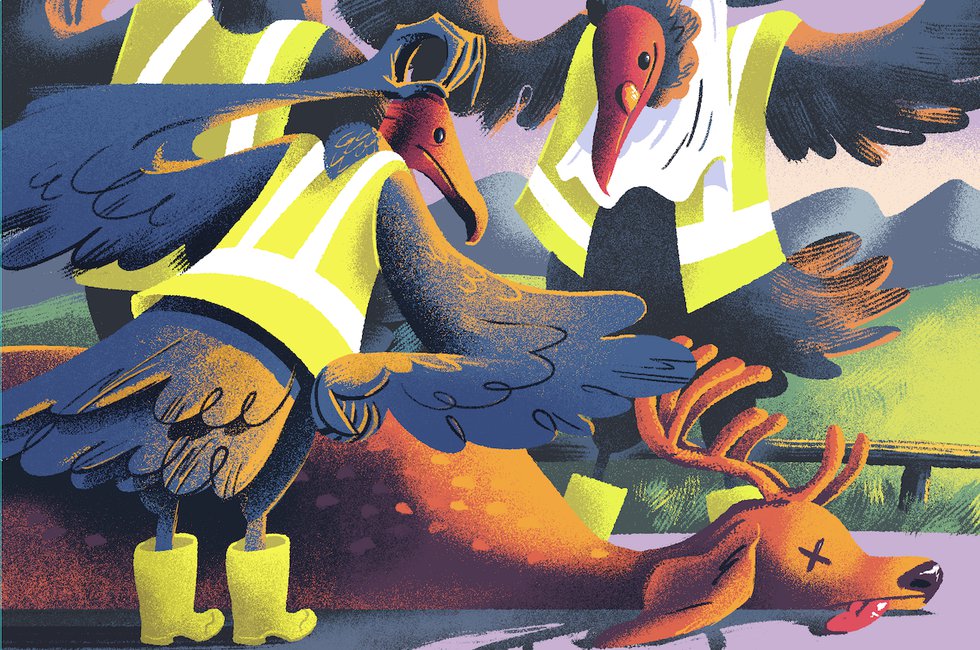Turkey vultures may not be attractive, but they are perfectly equipped for their niche in the cycle of life.

Illustration by Jan Bielecki
Nature did not endow the turkey vulture with a generous complement of charismatic qualities. On the ground, with its featherless red head, funereal black raiment, and awkward hopping gait, the adult turkey vulture wins no prizes for grace or beauty. Its call, when it makes any sound at all, is like a cross between a braying donkey and an angry goose. When feeling threatened, the turkey vulture’s defense is to vomit. And, of course, there’s that whole scavenging carrion thing.
Yet vultures are nature’s cleanup crew, perfectly equipped for the vital niche they fill in the cycle of life and ever vigilant for when next they can be of service. “I think they get a bad rap,” says Dr. Robert Sheehy, a professor of biology at Radford University in Radford.
Sheehy has been interested in turkey vultures since he helped rehabilitate one (affectionately nicknamed “Puke” because “every time we walked into the room he would throw up,” says Sheehy) many years ago. When Sheehy arrived to teach at Radford, he found there was a large vulture roost in town, and so, while turkey vultures have not been his main area of research focus, he has made “a recreational study” of the local population part of his work.
Turkey vultures, says Sheehy, have excellent eyesight and an extraordinary sense of smell. They can detect the scent of fresh carrion from as much as a mile away, and, he says, seem to keep a close eye on each other, as well, to see if another bird might have located anything interesting. Sheehy had an injured vulture that he trained as an educational aide. (She was named “Buttercup” after the character in Gilbert & Sullivan’s HMS Pinafore, although the kids, he says, thought she was named after the heroine from The Princess Bride.) “I would put her on carcasses, and other vultures would show up almost within five minutes,” he says. “They pay attention to each other.”
Vultures actually prefer their flesh fresh, not rotten, and they make quick work of whatever is for dinner. For the past seven years or so, Sheehy has maintained a “vulture cafeteria” on the grounds of Radford’s 380-acre Selu Conservancy to study the birds’ group feeding behaviors; he has found they can finish off the carcass of a fully grown deer in less than two days. (Want the video evidence? Follow the link from Sheehy’s web page under biology faculty at Radford.edu.)
Yet even a relatively fresh dead deer quickly becomes host to some nasty bacteria, so how do turkey vultures safely consume such a pathogenic picnic? According to Sheehy, very strong digestive acids seem to do the work. Sheehy’s students have attempted to culture bacteria from turkey vulture poop (that must be an interesting entry on their LinkedIn profiles), and “the poop was so clean it would kill things around it on a bacterial plate,” he says.
It has long been theorized that vultures’ heads are feather-free to keep them clean when they feed on carrion, but researchers from the University of Glasgow in Scotland found that the bare heads may serve a cooling function. Conversely, the birds will warm themselves by spreading their wings wide to the sun in a position known as the “horaltic pose.” And to complete your turkey-vulture terminology, a group of wheeling or circling birds in the sky is referred to as a “kettle,” a roosting group is a “committee,” and, a feeding group is a “wake” of vultures.
According to Sheehy, they are, in fact, quite social. “I was kind of surprised at how communal they are during much of the year,” he says, describing the birds hanging out together in a communal roost, sometimes also in the company of black vultures. They are also believed to pair monogamously across multiple seasons, or possibly for life.
And however ungainly turkey vultures might seem on the ground, in the sky they are masters of the air, able to soar effortlessly for hours. “Especially in the summer, when there are a lot of thermals, they can stay up all day,” says Sheehy. “Nothing flies as well as a vulture.”
In Tibet, notes Sheehy, people practice “sky burials,” where bodies are put out for the vultures to consume—“the ultimate green burial,” he says. Sheehy then quotes lines from the 20th-century poet Robinson Jeffers, who imagined himself consumed by a vulture and soaring as one with it into the air: “What a sublime end of one’s body, what an enskyment; what a life after death.”
In memory of John Kettlewell. This article originally appeared in our February 2020 issue.









